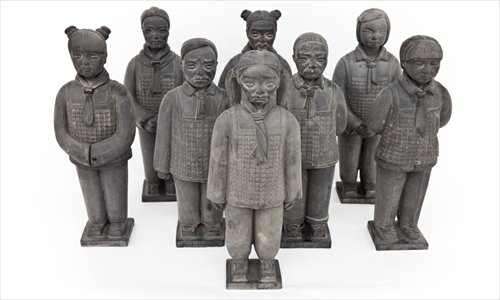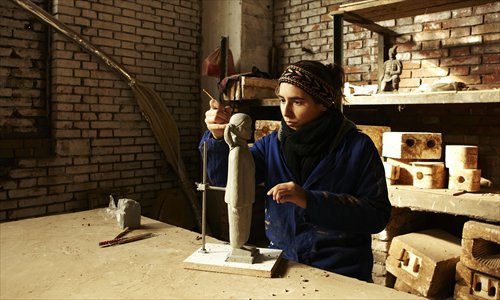Terracotta daughters
Clay has long been an important material for French sculptor Prune Nourry, so when she paid her first visit to China in June 2012, it was only natural that she visited the grand site of the Qin Dynasty (221BC-206BC) Terracotta Warriors in Xi'an, Shaanxi Province.
Before the trip, Nourry had been away from her studio in New York for about two years working on a project in India. Entitled Holy Daughters, the project focused on the issues of selective abortion and gender preference in India, drew inspiration from cows - the predominantly Hindu nation's sacred animal - and resulted in a series of sculptures depicting a hybrid of a cow and a girl.
Nourry's interest in gender preference continued on her China tour. It was during the first trip to Xi'an that she developed the frame of her art project in China, which is titled Terracotta Daughters.
Over one year later, the China project has finally been completed with the help of craftsmen and sociologists in Xi'an. Gallery Magda Danysz is currently showcasing Nourry's work from the project made over the past year.

Sculptures on show at the gallery Photo: Courtesy of Gallery Magda Danysz
116 life-sized sculptures
It's hard for visitors not to be amazed by the sight of 116 human-sized sculptures that are strikingly reminiscent of the archeological site in Xi'an, where visitors are only allowed to view the Terracotta Warriors at a certain distance.
But at Nourry's exhibition, visitors can walk among the standing figures that resemble Chinese girls dressed as Terracotta Warriors. The sculptures were made from the same clay and with the same techniques as the millennia-old warriors.
Eight of the 116 sculptures were based on real girls and made and signed by Nourry herself. The artist found a reputable workshop in Xi'an and learned from local craftsmen how to sculpt the way that Chinese people did 2,000 years ago. The other 108 statues were completed by local craftsman Weng Xianfeng, who assembled the parts of the eight original figures and improvised to give each girl a unique face.
"Gender preference exists in most parts of the world, but India and China, which occupy one third of the world's population, are more representative on this concern. And the two countries also represent the future," said Nourry, who hopes to show girls are important through her artworks.

Prune Nourry made the sculptures from the same clay and with the same techniques as the Terracotta Warriors. Photo: Courtesy of Gallery Magda Danysz
Working with sociologists
According to research on the sex ratio of children under six in India conducted by sociologist Ravinder Kaur, who worked with Nourry on the Indian project, the number of girls for every 1,000 boys decreased from 945 in 1991 to 927 in 2001.
Nourry also learned from sociologists at Xi'an Jiaotong University, who have been working on a program advocating care for girls in China, that the gender preference in the Chinese countryside is severer than that in cities.
Thus Nourry decided to meet the models for her terracotta daughters in the countryside. She joined an NGO that supports girls' education in rural areas of Shaanxi Province and found eight girls for her project.
Born in 1985, Nourry gained attention for exploring bio-ethics in her earlier works, such as The Procreative Dinner and Les Bébés Domestiques. Working with scientists and sociologists is a routine practice for her to complete her works.
"It's a good exchange because they give me the meaning and the books that I can read and learn during the research period of my project, and in return, I give visuals to explain their subjects in a more, I would say, a more popular way," added the artist.
Date: Until October 26, 11 am to 6 pm (closed on Mondays)
Venue: Gallery Magda Danysz Shanghai 上海MD画廊
Address: 188 Linqing Road
临青路188号
Admission: Free
Call 186-1615-1670 for details